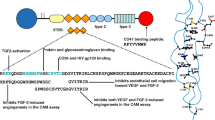Abstract
The aim of this study was to determine the role of tumor-derived angiogenic factors in solid tumor formation. We compared the angiogenic potential of tumorigenic and non-tumorigenic human tumor cell lines. All tumorigenic cell lines induced angiogenesis in vivo and their angiogenesis-inducing abilities were higher than those of the other non-tumorigenic cell lines. This in vivo angiogenic potential was well correlated with the in vitro endothelial cell growth-stimulating activity contained in the cell extract or conditioned medium of each cell line. The endothelial cell growth-stimulating activities of these cell lines were completely inhibited by neutralizing antibodies to basic fibroblast growth factor (bFGF), acidic FGF (aFGF) or vascular endothelial growth factor (VEGF). Furthermore, the levels of tumor-derived endothelial cell growth-stimulating activities depended on the amounts of angiogenic factors such as VEGF and bFGF produced by tumor cells. Although VEGF transcripts were detected in all of the cell lines by RT-PCR assay, the non-tumorigenic cell lines showed poor productivity of VEGF as well as FGFs and had less or non-potency for endothelial cell growth stimulation. These findings suggest that the increase in production of angiogenic factors by tumor cells is necessary for their in vivo angiogenic and tumorigenic potentials, and that VEGF and FGFs are the major mediators of tumor-induced angiogenesis.
Similar content being viewed by others
References
Folkman J. What is the evidence that tumors are angiogenesis dependent? J Natl Cancer Inst 1990; 82, 4-6.
Folkman J. Angiogenesis in cancer, vascular, rheumatoid and other disease. Nat Med 1995; 1, 27-31.
Folkman J, Shing Y. Angiogenesis. J Biol Chem 1992; 267, 10931-10934.
Moore R, Casey G, Brookes S, Dixon M, Peters G, Dickson C. Sequence, topography and protein coding potential of mouse int-2: a putative oncogene activated by mouse mammary tumour virus. EMBO J 1986; 5, 919-924.
Taira M, Yoshida T, Miyagawa K, Sakamoto H, Terada M, Sugimura T.cDNA sequence of human transforming gene hst and identification of the coding sequence required for transforming activity. Proc Natl Acad Sci USA 1987; 84, 2980-2984.
Hughes S, Hall P. The fibroblast growth factor and receptor multigene families. J Pathol 1993; 170, 219-221.
Shibuya M. Role of VEGF-flt receptor system in normal and tumor angiogenesis. Adv Cancer Res 1995; 67, 281-316.
Houck KA, Ferrara N, Winer J, Cachianes G, Li B, Leung DW. The vascular endothelial growth factor family: identification of a fourth molecular species and characterization of alternative splicing of RNA. Mol Endocrinol 1991; 5, 1806-14.
Houck KA, Leung DW, Rowland AM, Winer J, Ferrara N. Dual regulation of vascular endothelial growth factor bioavailability by genetic and proteolytic mechanisms. J Biol Chem 1992; 267, 26031-26037.
Hori A, Sasada R, Matsutani E, et al. Suppression of solid tumor growth by immunoneutralizing monoclonal antibody against human basic fibroblast growth factor. Cancer Res 1991; 51, 6180-4.
Kim KJ, Li B, Winer J, et al. Inhibition of vascular endothelial growth factor-induced angiogenesis suppresses tumor growth in vivo. Nature 1993; 362, 841-844.
Millauer B, Shawver LK, Plate KH, Risau W, Ullrich A. Glioblastoma growth inhibited in vivo by a dominant-negative Flk-1 mutant. Nature 1994; 367, 576-579.
Kakunaga T, Crow JD. Cell variants showing differential susceptibility to ultraviolet light-induced transformation. Science 1980; 209, 505-507.
Chomczynski P, Sacchi N. Single step method of RNA isolation by acid guanidinium thiocyanate-phenol-chloroform extraction. Anal Biochem 1987; 162, 156-159.
Sawano A, Takahashi T, Yamaguchi S, Aonuma M, Shibuya M. Flt-1 but not KDR/Flk-1 tyrosine kinase is a receptor for placenta growth factor, which is related to vascular endothelial growth factor. Cell Growth Different 1996; 7, 213-221.
Tanaka NG, Sakamoto N, Inoue K, et al. Antitumor effects of an antiangiogenic polysaccaride from an Arthrobacter species with or without a steroid. Cancer Res 1989; 49, 6727-6730.
Bagavandoss P, Wilks JW. Specific inhibition of endothelial cell proliferation by thrombospondin. Biochem Biophys Res Commun 1990; 170, 867-872.
O'Reilly MS, Holmgren L, Shing Y, et al. Angiostatin: a novel angiogenesis inhibitor that mediates the suppression of metastases by a Lewis lung carcinoma. Cell 1994; 79, 315-328.
Senger DR, Van de Water L, Brown LF, et al. Vascular permeability factor (VPF, VEGF) in tumor biology. Cancer Metastasis Rev 1993; 12, 303-324.
Abraham JA, Mergia A, Whang JL, et al. Nucleotide sequence of a bovine clone encoding the angiogenic protein, basic fibroblast growth factor. Science 1986; 233, 545-548.
Coltrini D, Gualandris A, Nelli EE, et al. Growth advantage and vascularization induced by basic fibroblast growth factor overexpression in endometrial HEC-1-B cells: an export-dependent mechanism of action. Cancer Res 1995; 55, 4729-4738.
Mignatti P, Morimoto T, Rifkin DB. Basic fibroblast growth factor released by single, isolated cells stimulates their migration in an autocrine manner. Proc Natl Acad Sci USA 1991; 88, 11007-11011.
Nguyen M, Watanabe H, Budson AE, Richie JP, Hayes DF, Folkman J. Elevated levels of an angiogenic peptide, basic fibroblast growth factor, in the urine of patients with a wide spectrum of cancers. J Natl Cancer Inst 1994; 86, 356-361.
Nanus D, Schmitz-Drager B, Motzer R, et al. Expression of basic fibroblast growth factor in primary human renal tumors: correlation with poor survival. J Natl Cancer Inst 1993; 85, 1597-1599.
Author information
Authors and Affiliations
Rights and permissions
About this article
Cite this article
Aonuma, M., Iwahana, M., Nakayama, Y. et al. Tumorigenicity depends on angiogenic potential of tumor cells: dominant role of vascular endothelial growth factor and/or fibroblast growth factors produced by tumor cells. Angiogenesis 2, 57–66 (1998). https://doi.org/10.1023/A:1009054410624
Issue Date:
DOI: https://doi.org/10.1023/A:1009054410624




